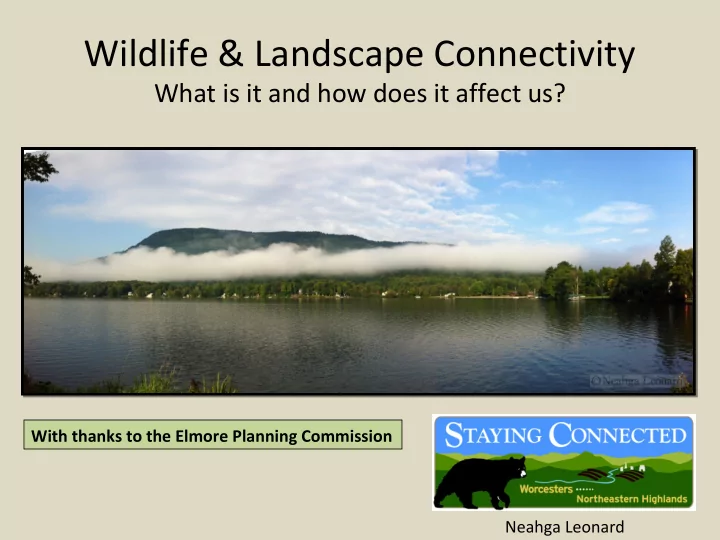

Wildlife & Landscape Connectivity What is it and how does it affect us? With thanks to the Elmore Planning Commission Neahga Leonard
American Black Bear ( Ursus americanus )
Poor eyesight, but good hearing, and exceptional sense of smell
Agile, delicate, and cautious despite their size and strength She caught my scent when the wind turned, and fled
One bear needs approximately 19,000 acres, or 30 square miles The entire field of view in this image is about 13,000 acres, or 20 square miles
Area Dependent Mammal Species Area Dependent Mammal Species Moose 1,280 - 12,800 ac Bobcat 5,760 ac (@10sq mi) (@2-20sq mi) Fisher 4,747 - 9,600 ac Black Bear 19,200 ac (@30sq mi) (@8-16sq mi) River Otter 15-30 linear miles (SGCN) (DeGraaf & Rudis 1986)
Why do so many animals need such a large area? Food , Mates, and Denning sites Bobcat Energy Requirements Minimum Prey Requirements for a resting male (15kg) during a 120 day winter period: •1.8 deer OR •63 snow shoe hare OR Due to activity, cold temperatures, X 3 •3633 small mammals OR and/or lactation •102 squirrels •Snow depths > 5” starts to restricts bobcat movements •Sunning on ridges limits energy expenditures •Winter pelage allows bobcats to survive temperatures 32 degrees F colder than summer without increase in metabolic rate
Of 7 linkages in New England, 5 fall at least partially within Vermont
Worcester Range – the lynchpin of connectivity in north central Vermont
What does Wildlife Connectivity look like? Large areas of core habitat, suitable for a wide variety of wildlife Areas where wildlife linkages or large habitat blocks currently exist in key locations to facilitate landscape level movement
Stowe/Morrisville Border
Elmore & Wolcott
This year loons nested at the Sothern edge of Lake Elmore
The wetlands and forests of Elmore provide homes for a variety of wildlife
Thinking about and acting upon connectivity does not mean giving up our way of life, it means enhancing and enriching it.
How Can You Get Involved? Join an informal association • Vermont Coverts • Vermont Woodlands Association • Friends of the Winooski • Vermont Trappers Association Get involved with your town • Conservation Commissions • Planning Commissions • Select Boards • Regional Planning Commissions Talk with some of the land management agencies • Vermont Land Trust • Vermont Natural Resources Council • Trust for Public Land • The Nature Conservancy
Citizen Science Projects
Participation in Fish & Wildlife projects
The land belongs to those who live on it and who use it The future of the land rests in their hands
Recommend
More recommend